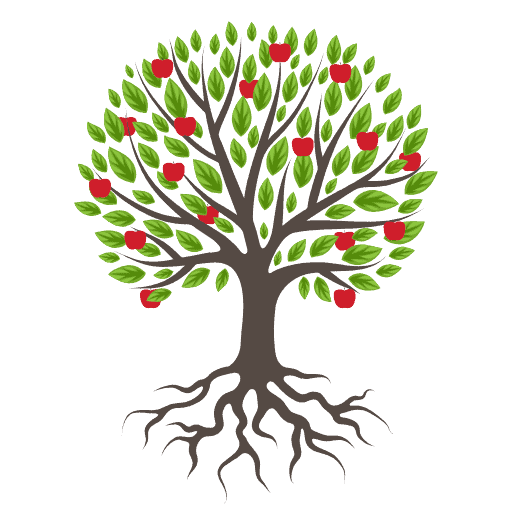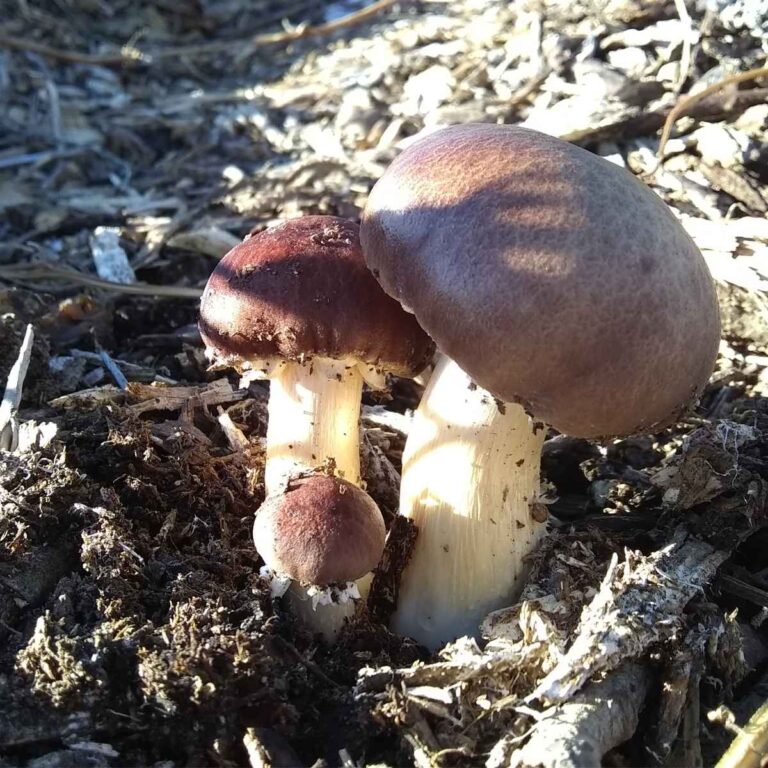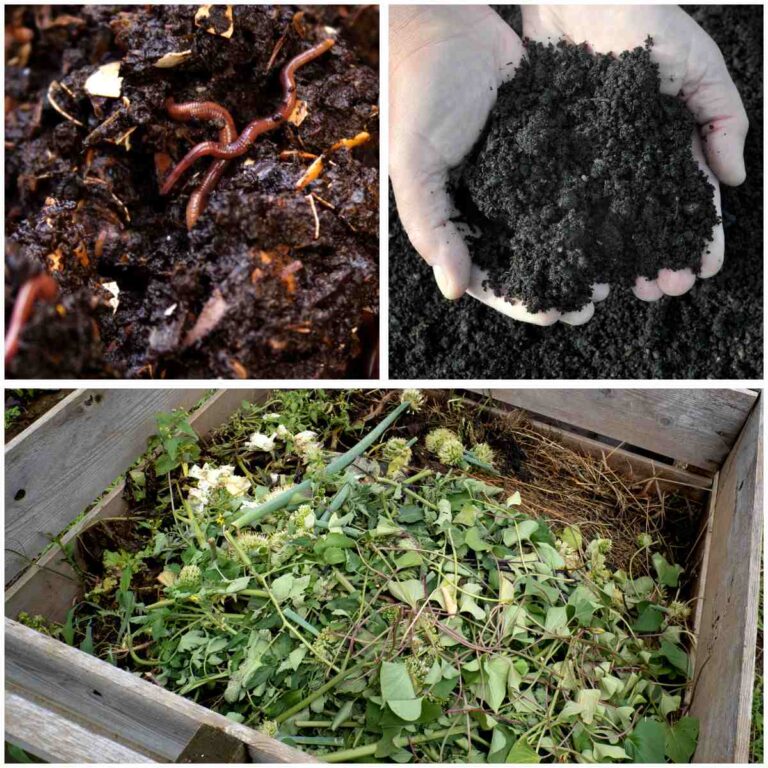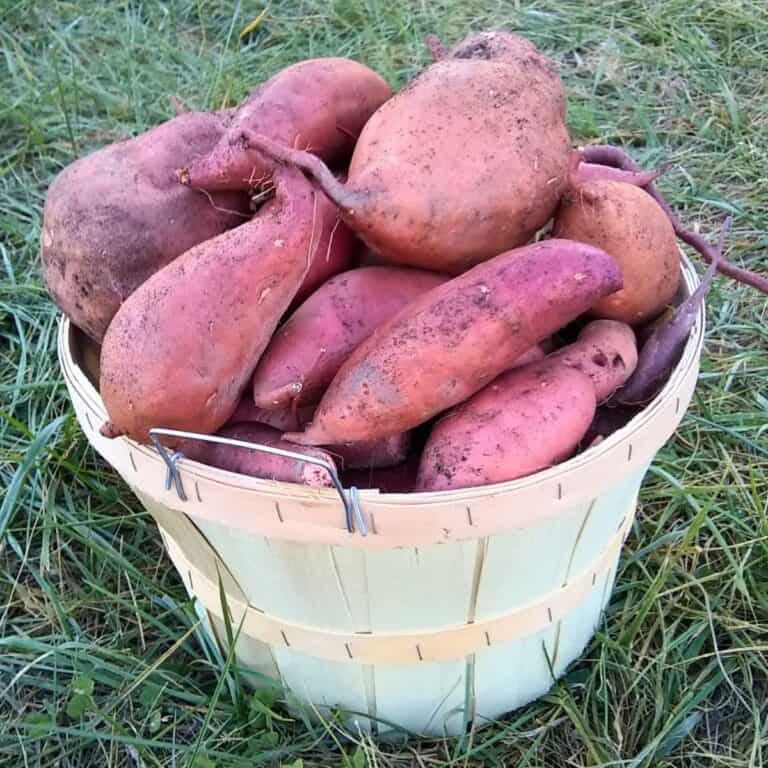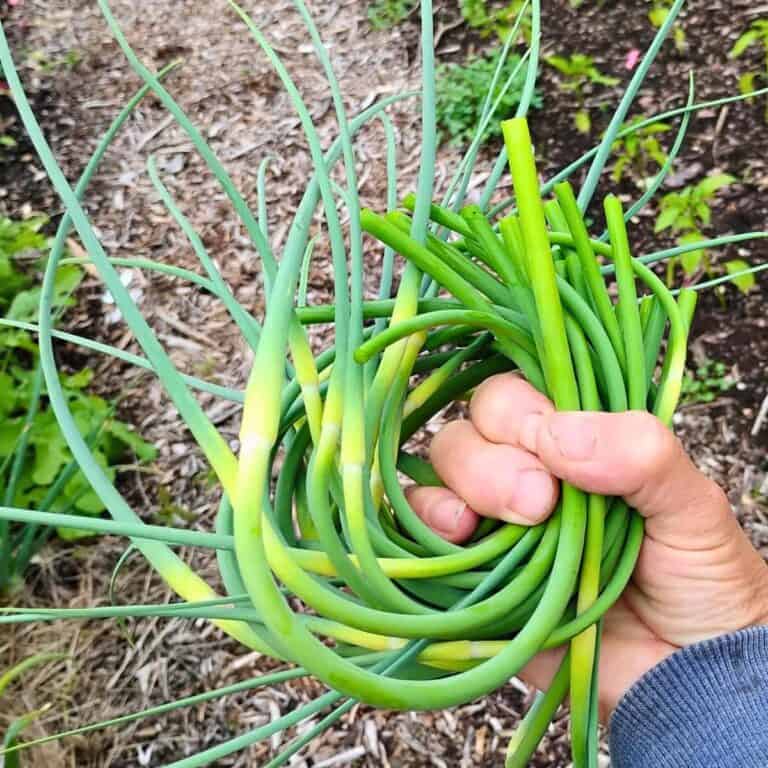How to make mulch from wood chips. Short- and long-term benefits in gardens, permaculture tree guilds and food forests.
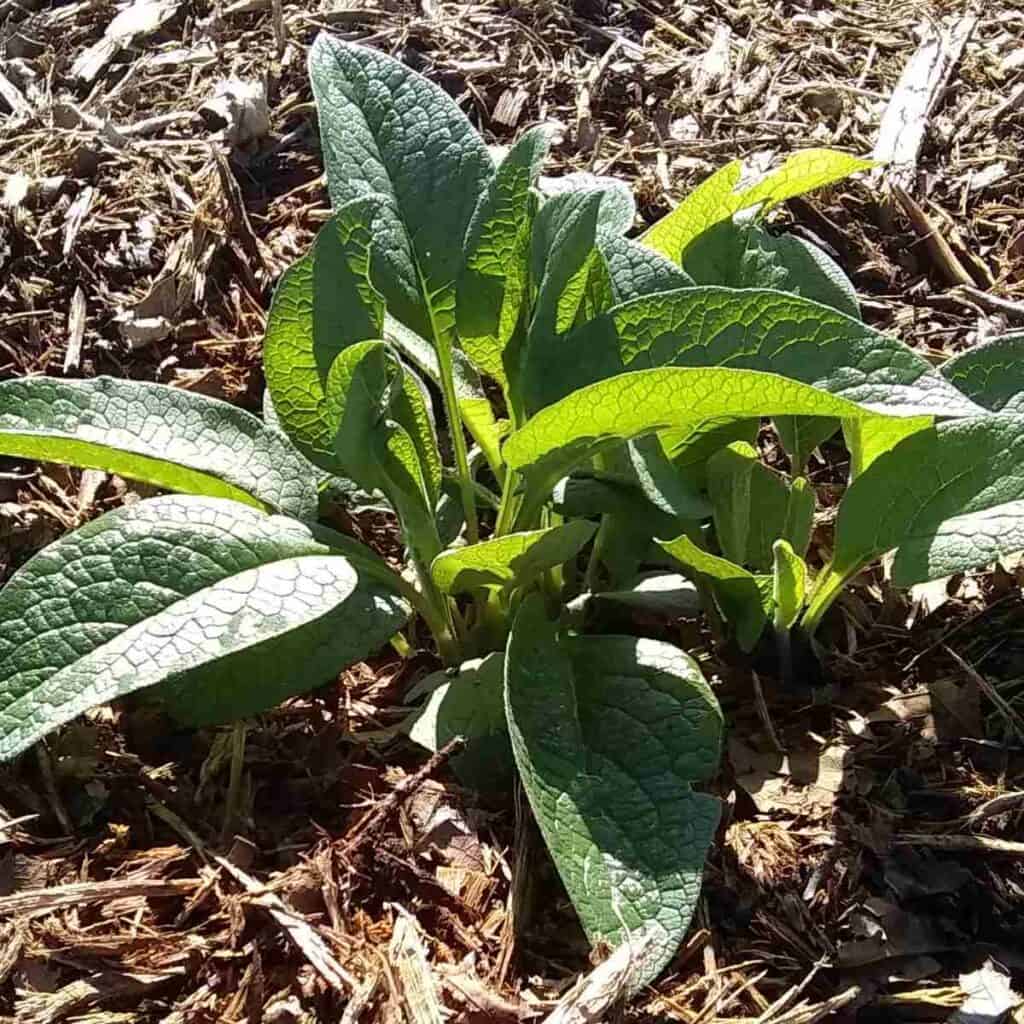
This post contains affiliate links. As an Amazon associate I make a small commission at no extra cost to you on qualifying purchases. See my full disclosure here.
Wood Chips Are An Essential Part Of My Garden Designs
Many years ago, I learned about the benefits of wood chips. I was very intrigued and started to use them in my garden paths. Over the years, my interest has only increased.
Now I use wood chips not only in garden paths, but as a superior organic mulch in contour plantings on slopes, on walkways, and in Permaculture tree guilds. Besides that, I also use it to grow mushrooms and make mini Hugel beds.
Currently I am starting a food forest orchard here at my new location. This will be planted on-contour along my hillside slope. My plan is to use wood chips to fill swales, meant for catching water that would otherwise run off. This is going to keep my fruit trees hydrated.
Wood Chip Mulch In A Perennial Permaculture Garden:

My main focus here on my farm is perennial Permaculture gardening. However, I inter-plant with some annual crops and I do keep a small annual vegetable garden.
My main goal though, especially as I’m not getting younger these days, is to grow most of my food in a perennial system. I am hoping to reduce my workload for the later years.
Wood chip mulch is a major component in this kind of garden. Check out my post on how to start a food forest from scratch and how to grow it as big as you want a few square feet at a time.
Wood Chips Have Become An Obsession
My fascination with wood chips, their many uses and potential is only diminished by the reality of not ever having enough.
I ended up with the ‘mother lode’ of wood chip drops last fall, 4 huge piles from the road cleanup crew. It looked like such a huge amount. But now that I started using them, they are going away so fast. So it’s time to start looking for more.
There are many different types of mulch and each has their own pros and cons. Leaf mulch for example is similar to wood mulch in that it is fungal-dominated.
If you can find fresh Arborist wood chips, leaves will be included if the tree was not felled in winter. And that combination makes the most excellent mulch, resulting in great biodiversity.
In this post I will write about my favorite uses for wood chips, the benefits of wood chip mulch, how to make mulch from wood chips, and how to acquire or make wood chips.
Some Of The Many Uses For Wood Chips

Of all the ways to use wood chips, my favorite is to apply them as mulch in paths and around perennial plants and trees.
For your annual garden beds, it is best to use mulches that will break down faster, such as grass clippings, straw, chopped fresh or dry leaves, weeds before they go to seed, and partly decomposed hay if you don’t fear a few weed seeds. There are many uses for wood chips, which I’ll briefly mention below.
- Superior mulch for garden paths.
- Mulching the base of trees, tree guilds and perennial gardens.
- Use as mushroom growing substrate.
- Pile it up and let it compost. However, this takes a long time but when finished, you can use it as all-purpose compost.
- Make a mini Hugel style raised garden bed.
- Use thickly in swales to prevent soil erosion and to make a nice-to-walk-on path instead of having a muddy ditch there. Here is a link to one of my favorite videos that teach what swales are, with instructor Geoff Lawton.
- Use wood chips instead of gravel to make walkways around your property. Just be aware that you’ll find splinters instead of gravelly bits making their way into your slippers as you walk. But it will be a nicely springy and more quiet walk. I prefer it over any other material.
- Use anywhere, where you have muddy conditions during rainy periods.
- Layer some in your barn as Livestock bedding.
- Make useful bug hotels for your garden.
Making Mulch From Wood Chips has many benefits

I used some wood chips in the pots to keep the moisture in during dry spells. Here I’m growing lots of squash on a trellis and one of my favorites, the cucuzza, an italian squash that can be used like zucchini. It has a very small seed core and is mostly all dense meat. It’s awesome, sauteed with garlic, onions and tomatoes, and can be used on pasta, rice or baked potatoes. Yum!
One reason I like wood chips so much is that they provide so many benefits for the garden and the gardener. And I feel that mulching on location is preferable to making compost in a pile or bin for many reasons.
Read more about that in 22 Types Of Compost, Methods And Uses. But wood chip mulch, especially when arborist wood chips are used, is chuck-full of goodies as I outline here. Arborist wood chips are chips from a fresh felled, living tree that include leaves.
This makes the very best wood chip mulch for your garden. Wood-chip mulch that contains all parts of the trees, including green leaves and tree bark increases biodiversity.

List of the Benefits:
- Weed control: Spreading wood chips over the soil surface will suppress existing weeds and prevent weed seed germination. That means no more mowing.
This makes it very useful in garden paths. If you want the mulch to last a long time choose cedar, oak, hickory or locust chips. Weed Seeds can blow in over time and might get established on top of the wood chips. But they will pull out very easily and a fresh layer of wood chips will suppress new weeds. - Soil-building: Wood chips will break down eventually and become soil. That is why you will have to reapply wood chips after a time, but it will create super rich humus. It will also add organic matter, improve consistency and water holding capacity of the soil, all without tilling.
- Improve water infiltration and retention: An area covered with wood chips will retain moisture for a long time even in drought conditions.
It will also prevent evaporation from the soil underneath. Which means that you will not need to water as much, if at all. As an added benefit, wood chip mulch will increase infiltration of rainwater by improving soil structure which will increase soil moisture. - Control soil erosion: Wood chips help to control soil erosion and prevent muddy washed out garden paths. Just apply a layer anywhere you have bare soil. Wood chips can also act as walls for your garden beds, keeping your garden bed soil contained, if they are not framed.
- Soil Temperature regulator: Wood chip mulch can help keep the soil cooler in summer and warmer in winter, possibly preventing frost damage to the roots.
They can be used in a Hotbed in the greenhouse or outside, to get an early start on growing vegetables. The heat that is generated by the decomposition process, will serve the same function as a heating mat for seedlings. - Aesthetics: Wood chips make the garden look nice
Here are some added benefits beyond the more obvious:
- Increase soil health: As wood chips break down, microbial activity increases. Decomposers turn the organic material into rich humus, which results in a healthy soil. There will be increased biodiversity and a higher population of beneficial microbes in the soil and the area around where it’s applied.
- Decreases compaction: By improving soil structure, wood chips will decrease compaction in the area where they are applied.
- Neutralize pollutants: Some of the microorganisms that the wood chips attract and feed, can decompose pollutants in contaminated soil.
- Create mushroom compost: As fungi break down wood chips, your mulch becomes ever more valuable. The result is highly beneficial for perennial, undisturbed gardens.
It is especially great for trees, who rely on the mycorrhizal pathways for acquiring much of their nutrient supply. Wood chip mulch decomposes to become a desirable fungal-based mushroom compost. - Disease control: Cedar or pine chips can repel fleas and other pests. A mulch of wood chips can help prevent soil-borne fungal disease such as blight that can splash up on plants from uncovered soil when it rains.
Mulch in general will suppress pathogens and enhance beneficial organisms. Many fungal pathogens live in the soil and are opportunists. And if a tree shows signs of distress, they may attack. A wood chip mulch contributes to a strong-growing healthy tree and the chance for any pathogen attacks will diminish. - Provide nutrients: As wood chips break down, they feed nutrients to the tree roots. Increased microorganism populations will mine nutrients from the soil and rock.
They will then pass these on in symbiotic trade relations to trees, shrubs, perennial vegetables, and flowers. This will increase the health of the plants and, in turn, the nutrient content of the edible parts. - Less Work: Less or no mowing, weeding and watering!
- Enhance plant productivity: Wood chip mulch will slowly release nutrients into the soil for the plant to use, which will help the plant grow healthier and more resistant to disease and pest.
Bonus: Grow Mushrooms in your Wood Chips

Wood Chip Mulch Drawbacks And Common Concerns:
As with all things, there are some possible problems to consider when gardening with wood chips:
- Nitrogen thief: Wood mulch can possibly rob nitrogen from your plants if you end up working them into the soil.
As a mulch they only affect the few millimeters of soil where the two touch. In my observation, if you apply wood chips on top as mulch, this will not affect plant growth adversely. I don’t use them as mulch in my annual garden beds.
Annual vegetables prefer bacteria-dominated compost and mulches that break down quickly. Wood chips tend to take a long time to break down, so you have to brush them aside and reapply whenever you sew new seeds.
My favorite way to mulch my annual vegetable garden beds is to take the wood chip compost from the bottom of the walkways once they are decomposed.
That is now usable as mulch on the garden beds beside them. Other options are compost, grass clippings, green leaves, or green manure clippings around your annuals.
These will break down quicker, fueled by bacteria, creating an environment that annual plants love. I also like to use pine bark as annual garden mulch. I actually mix pine-bark into my raised bed soil as an aeration and moisture holding agent. It will not affect plant growth like chips from wood when mixed into the soil. - Wood chips from diseased trees: Diseases do not transfer to roots of healthy trees through several inches of soil. It is not usually a concern to use these chips as mulch. Pathogens attack unhealthy plants.
But healthy fungi that will start to dominate the wood chips over time, will eliminate those pathogens eventually. I have used diseased wood chips in the past and found that no problems were created.
If you are concerned, you can do two things: Make a compost pile with the diseased wood chips in a corner somewhere until they are partially decomposed, then apply them as mulch. You can also make biochar from this wood.
- Walnut worries: Black walnut trees contain several chemical compounds which can have an allelopathic effect on plant growth. There is controversy on the claim that mulch from black walnut trees exude that effect. Some studies suggest that the amount of these chemicals varies from tree to tree and season to season.
The prohibitive chemicals are most concentrated in fresh hulls and leaves but not so much in the wood. These chemicals also tend to get neutralized by favorable soil conditions. I do not worry about walnut material in my mulch. But if you’re concerned, you might want to pass on walnut wood chips.
- Eucalyptus: Wood chips from Eucalyptus trees, might inhibit plant growth if used as mulch.
- Pine trees: Pine trees and Pine needles are not a concern contrary to what some say. They make excellent mulch, which has great moisture retention properties.
- Toxic wood chips: Be wary of wood chips that are not from logs. If they contain pallet wood or treated wood, they can be toxic.
- Colored wood chips: In my opinion these have no place in a food-growing garden or around a fruit tree. They have no place anywhere in my garden. They contain fungicides that kill microbes and suppress decomposition. And they contain chemicals that add ‘decorative’ color. Not something I want leaching into soil and consequently my food. Keep it natural and it will be beautiful.
- It’s easy: Compared with other soil enhancers such as composting or sheet mulching, putting down wood chips is super easy, especially when you can have them delivered.
How To Acquire Wood Chips For Mulch?
Small Scale
If you need just a small amount of mulch for a few planting pots on your patio for example, good sources are the garden center or the local hardware store. There you can purchase all sorts of wood chips or pine bark from plain to decorative, in 2 cu ft plastic bags for fairly cheap. I’ve done this many times.
Do be aware of some issues that can arise with those bagged wood chips or bark mulch. They are not necessarily purely organic material.
They often contain dyes for decorative purposes and fungicides that kill soil life. I suggest you avoid those, especially if they will be used as mulch around edible plants.
I will be posting some of the dangers of chemical use in the garden in another post. Sign up to receive my Weekly Newsletter for updates.
Medium To Large Scale

Making mulch from wood chips for a few fruit trees is a much bigger scale. It takes a lot of mulch for a tree base, and you will save a lot of money if you buy it in bulk.
Check around your area for garden centers or landscape suppliers who sell wood chips in bulk. Sometimes you can find playground chips, which are often made of cedar. They will usually load you up with a few tractor buckets full of the chips. It takes a lot of chips to cover a 10-15 foot diameter base of a fruit tree.
Other places to check out are your local sawmill, lumber yard, arborist tree service, county highway maintenance or road clean-up crew, electric company, and current logging sites.
Some, such as road clean-up crews, might agree to deliver them to you for free instead of taking them to the landfill where they have to dump them for a fee. You could also try your local christmas tree recycler in January.
Give Getchipdrop A Try
If you can’t find local sources, you might want to try getchipdrop.com. They contract with arborists and forestry services in your area, providing them with lists of nearby drops.
If you’re close to a tree-felling site, you might get lucky. The chips are free. Personally I did not have any luck with them. I even opted to pay the optional $20 fee to receive preference. I’m assuming that it depends on what area you live in to get that service. Some areas also have a local version of a chipdrop look up arborist services for that.
Where I lived in Washington, it was hard to acquire any free wood chips. I did find some on craigslist, where a person had a pile in their yard, which they wanted removed, so I went a couple of times to fill up my pickup with a shovel.
All the arborists I contacted told me that people wanted to keep the wood chips after they had a tree removed. Some also asked for a fee to dump their wood chips.
Fortunately there was a large landscaping supply company not too far away, who sold wood chips, bark mulch, and compost. They would load me up with nice playground chips for about 25 dollars per cubic yard of mulch 5 years ago.
The biggest challenge when gardening with wood chips is to get your supply. If all else fails, you can opt to make your own wood chips.
Make your own Wood Chips
You can make your own mulch from wood chips from windfall branches and woody debris that you can find after a storm.
What an awesome way to turn garden waste into an asset. While you clean up your own, check with your neighbor, they might love you even more if you take their yard waste off their hands. If you have a woodlot, definitely look at this option.
If you have a huge amount of wood to clean up, then besides making wood chips you can also make biochar, another very beneficial product for your garden.
Home-sized Wood Chipper
Wood chips can easily be made with a wood chipper. Home-sized wood chippers range in price from about five hundred to several thousand dollars. They generally accept branches that are up to 3 inches in diameter. However, I find that you can really only fit up to 2 ½ inch branches through the hopper, especially if they are hardwood. I actually limit the size to about 2 inches, or I have too many issues while running it. The bigger ones will become firewood.
PTO Wood Chipper
If you have a lot of wood to process and you own a PTO equipped garden tractor or a full-size farm tractor, consider a 3-point hitch PTO chipper attachment for it.
I don’t own a tractor, but from all the reviews I have read, this is far more powerful than a home-size chipper and preferable. You can also feed in larger diameter branches. However, I like to save the larger ones for firewood in my woodstove or to grow mushrooms on.
Renting a wood chipper
You might be able to rent a wood chipper if you don’t want to spend a lot of money on equipment that you might not use often.
Consider also that you will have to store it while it’s not in use. Check with your local garden center, many have an equipment rental service. Renting is also a great way to try one before you buy one. See if you feel that it’s worth the investment.
My own wood chipper review
I own a Harbor Freight predator model, and while it does the job, it takes a lot of time and material to make a decent size pile of chips. The tree limbs have to be prepared.
Trim off all stiff tree branches that stick out from the main limb and cut the longer ones into manageable sizes. The engine stalls occasionally, especially when feeding large diameter hardwood or long branches, so I keep the hardwood diameter fairly small and the branches short.
It also clogs up easily and then I need to take it apart to clean it out. That can be a real chore if a chunk of wood is lodged tightly between the choppers and the wall.
Long, skinny branches do not work well in it, they often wrap themselves around the choppers. It helps to feed skinny branches along with a thicker one.
Leaves do not shred well either, it is best to get a dedicated leaf shredder for that or use your mower or weed wacker. Dry wood is easier to chop than wet wood.
I’ve made a lot of wood chips with my Harbor Freight model. I don’t think it’s the greatest, but it was reasonably priced, came with a 2 year warranty, was available locally and it has served me well enough.
How To Make Wood Chip Mulch?

Making wood chip mulch depends a little on what you’re trying to mulch and what kind of mulch is available to you.
My favorite way to use wood chips for mulch is in garden paths and around my perennial planting area. I prefer to layer the ground with cardboard or paper before applying the wood chips. This will help suppress vigorous perennial weeds from poking through and hopefully kills them eventually.
If you have several types of hardwood and softwood available, it makes a greatly diverse mix and will attract a more diverse set of decomposers to your site. I like to have as many species as possible in the mix, along with the leaves.
In case you have lots of cedar, locust, oak, or hickory on hand, you can sort these out for areas where you want a slower rate of decomposition. This could be around a fruit tree, walkways, or garden paths.This can stretch the time before you need to add more.
Perennials grow especially well with wood chip mulch because it is fungal-dominated. Fungal-dominated woody material is best left alone and not disturbed once it gets applied.
In contrast, annual vegetables thrive in a bacterial-dominated compost. This is apparent in nature as well, as annual plants start to appear first on a disturbed site that introduces a lot of bacterial activity. Perennial weeds and eventually trees follow the annuals.
Once the soil settles and is mostly covered with perennial plants, the soil inhabitants gravitate toward a more fungal domination.
How To Mulch Garden Paths:

If you have a lot of cedar wood chips, they work really well in garden paths. Layer about 4-6 inches thick to suppress weeds and retain moisture in the ground.
Cedar also helps deter pests due to some naturally occurring chemical compounds that it releases. It takes a long time to break down too, so you won’t have to reapply as often. I think too, that it gives off a nice scent as you walk around in your garden.
Once the bottom layers in your walkway are decomposed, you can just rake the top layer to the side, and use the decomposed bottom layer on your vegetable beds as top dressing. Then add more fresh chips on your garden path.
I like to layer cardboard or paper before adding the wood chips to the garden paths. Paper from packaging, used paper feed bags (if there is a plastic liner, remove it first), and old newspapers work great for this as well.
How To Make Wood Chip Mulch For Trees:

Mow an area around your tree that is about as large as your tree’s drip line, very short. Cover with paper or cardboard. Layer wood chips about 4-6 inches deep on top of the cardboard. If you have plenty of wood chips it’s OK to pile it higher.
Be sure to leave a few inches around the tree trunk free from mulch. The trunk can rot and rodents might damage it, if it sits in inch deep mulch. Renew if needed in the second year or when you notice weed growth.
This mulch is especially beneficial for trees because it is fungal-dominated. Trees thrive on a symbiotic trade relation with fungi who use mycorrhizal pathways for acquiring nutrients and minerals that the tree needs to grow healthy. The tree, in exchange, feeds the vast herds of soil microorganisms. The result is greater than a win-win.
How To Mulch Perennial Tree Guilds:

My very favorite way to garden is to establish Tree Guilds. These can be expanded into small or large Food Forests. I find wood chip mulch is one of the most important ingredients in a successful food forest garden, besides the plants themselves. Check out my post on establishing Tree Guilds from scratch, which shows more detail about the process.
Here is how to make mulch from wood chips in a perennial fruit tree guild. First, plant a fruit tree. You can find instructions in my post Prepare The Soil To Plant A Fruit Tree.
Then dig a few smaller holes about 5 feet away from the trunk of the tree. I make as many of those as will fit around a 5 foot radius perimeter, about 3-5 feet from each other.
Leave a path for access to the tree. Here you can plant shrubs, such as berry bushes, brambles or leguminous shrubs. Leave enough distance between your young plants for access and to accommodate the plants once mature.
Plant your sun-loving shrubs on the south facing side and the shade-tolerant ones to the north of the tree.
Next I layer cardboard or paper around the tree and shrubs, to about 8 feet out from the tree trunk. This gives me a 16 ft diameter area.
This I cover with a thick layer of wood chips, about 6 inches deep. It is important to leave a little breathing room around the trunks of the tree and shrubs to keep them healthy.
This is all you need to do for now. Add more wood chips in a few years, once the current ones start to decompose, or when weeds start to grow on the old ones.

Filling the bare spots
I like to plant different things into the mulch that can grow there until the tree gets large. To do this, I dig a large hole into the wood chips till I expose the cardboard, make a slit in it for the plant roots and fill the hole with compost or potting soil.
I then plant annuals, smaller perennials, or herbs into those holes. The paper will deteriorate pretty soon underneath and the plant roots can access the native ground as they grow larger. Think strawberries, asparagus, comfrey, garlic, artichokes, cabbage, pumpkins and so on.

Now I can work on enlarging my food growing tree guild when I can find the time and wood chips. This can expand in an ever widening circle or snake along a hillside contour, expanding in just one direction.
Go to ‘How to grow a food forest‘ for more information. If you would like to have a downloadable and printable quick reference booklet of how to plant a food forest, you can purchase it on Etsy.
How To Make Mulch From Wood Chips For Filling Raised Beds:

Here is a great way to fill your raised garden beds, that will be easier than mixing a lot of soil. Make a Hugel-style bed. You’ll want to leave room for at least 6 inches of topsoil.
So fill your raised bed to within 6 inches from the top with tightly packed wood chips, to make a fairly dense layer to start. I walk on it to pack it down.
Cover with a layer of manure, animal bedding, green materials or other material that is high in nitrogen, to keep the bugs fed that will be working on decomposing your wood chips. This will prevent them from stealing nitrogen from your plants.
Add 6 inches or more of topsoil or raised bed soil mix to fill the bin. The wood base will decompose over time and shrink a little, so just keep topping with compost each year.
The woody layer will retain moisture and, if thick enough, provide warmth like a hotbed, as it decomposes. You can get a head start in spring for growing cold hardy crops. This is also a great way to solve a drainage problem in your native soil.
A Word Of Warning About Growing In Wood Chips:
It is important to know that you cannot plant directly into wood chips. Your plants will need the nutrients that are available in soil. Fresh wood chips do not contain what a plant needs.
So when planting in an area that has been mulched with wood chips, be sure to pull all the wood chips aside where you want to plant and put a few scoops of compost or potting soil into the hole, cut a slit in the cardboard underneath, and plant your seedling into that hole full of compost.
Then you can take the wood chips and pile them over the soil and around the plant.

Final Words:
If you can get your hands on some wood chips, I highly recommend you add them to your garden in one or more ways. Maybe you’ll become as much a wood chip fanatic as I am. Let me know in the comments below! Do you have questions about how to make mulch from wood chips? Have you found other uses for wood chips? I look forward to hearing it all.
More On Gardening With Wood Chips And Growing Guides:
Grow mushrooms at home in your garden This is one of the most rewarding experiences in wood chip gardening. Grow your own mushrooms intentionally. It’s easy and they taste so delicious!
How to grow a food forest one Tree Guild at a time Plant one tree or many trees when you can. Create ecosystems in your backyard by planting companions for your trees and filling the space around it with food producing plants.
How to prepare the soil to plant fruit trees How to prepare your planting hole, what to put in it and how to give your tree the best odds for growing up strong and healthy.
How To Grow Bigger Onions – A complete tutorial on growing onions from seed to storage.
Grow Your Own Sweet Potatoes – How to grow slips, plant them, care for your sweet potatoes, harvest and cure them. Don’t miss out on growing your own nutritious, edible sweet potato greens too!
How To Get Bigger Garlic – What to do to get big and healthy garlic bulbs. When and how to plant and harvest.
How to make 18-day compost – The best compost for your garden beds in less than 3 weeks.
22 different types of compost There is surely a way you can compost. Either in your backyard or in your kitchen. Composting fits all sizes and situations.
Pin this post

Shop This Post
Harbor Freight predator model
getchipdrop.com
Get Wine Cap Spawn Here
[pt_view id=”d25d36cip0″]
